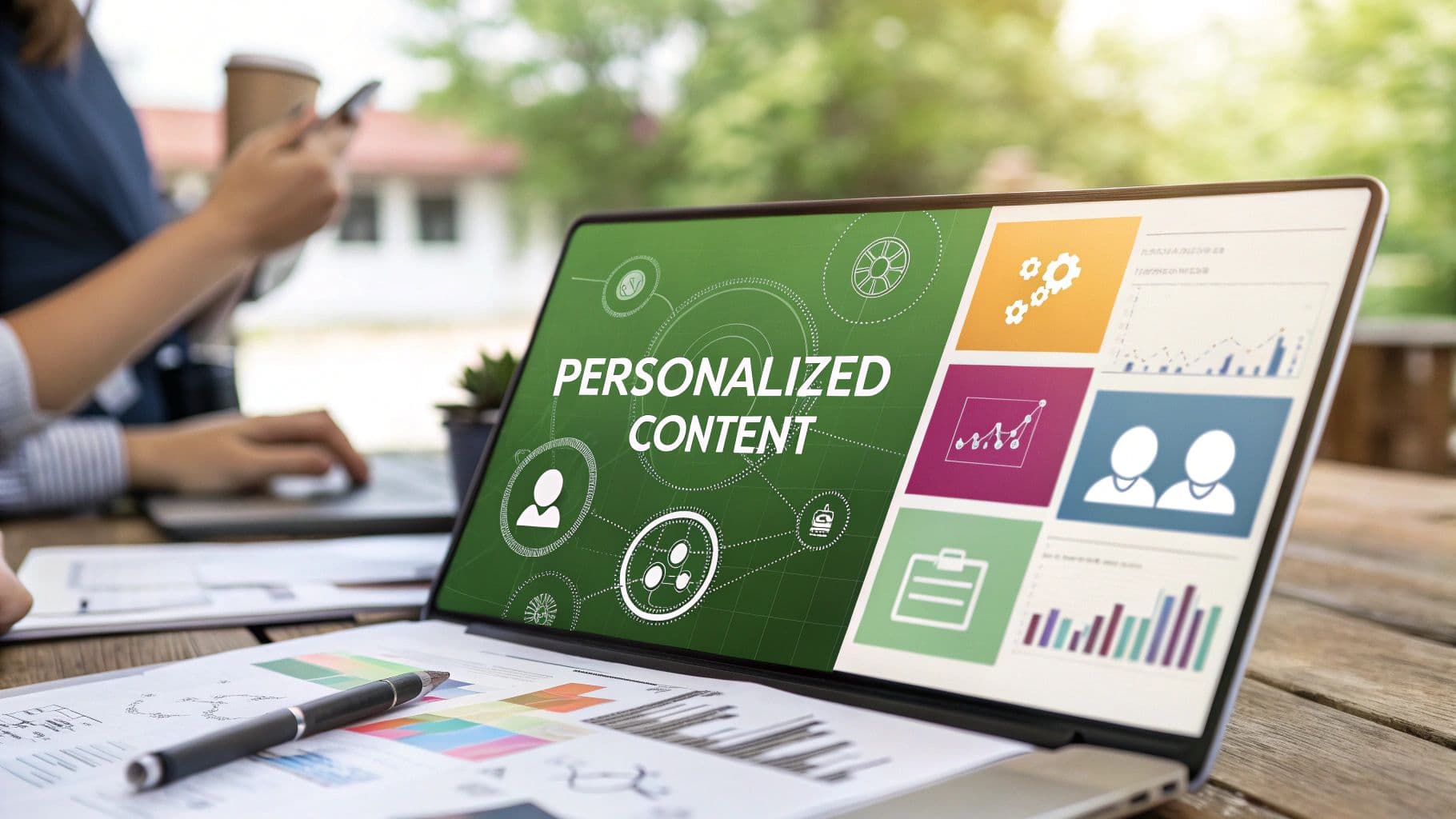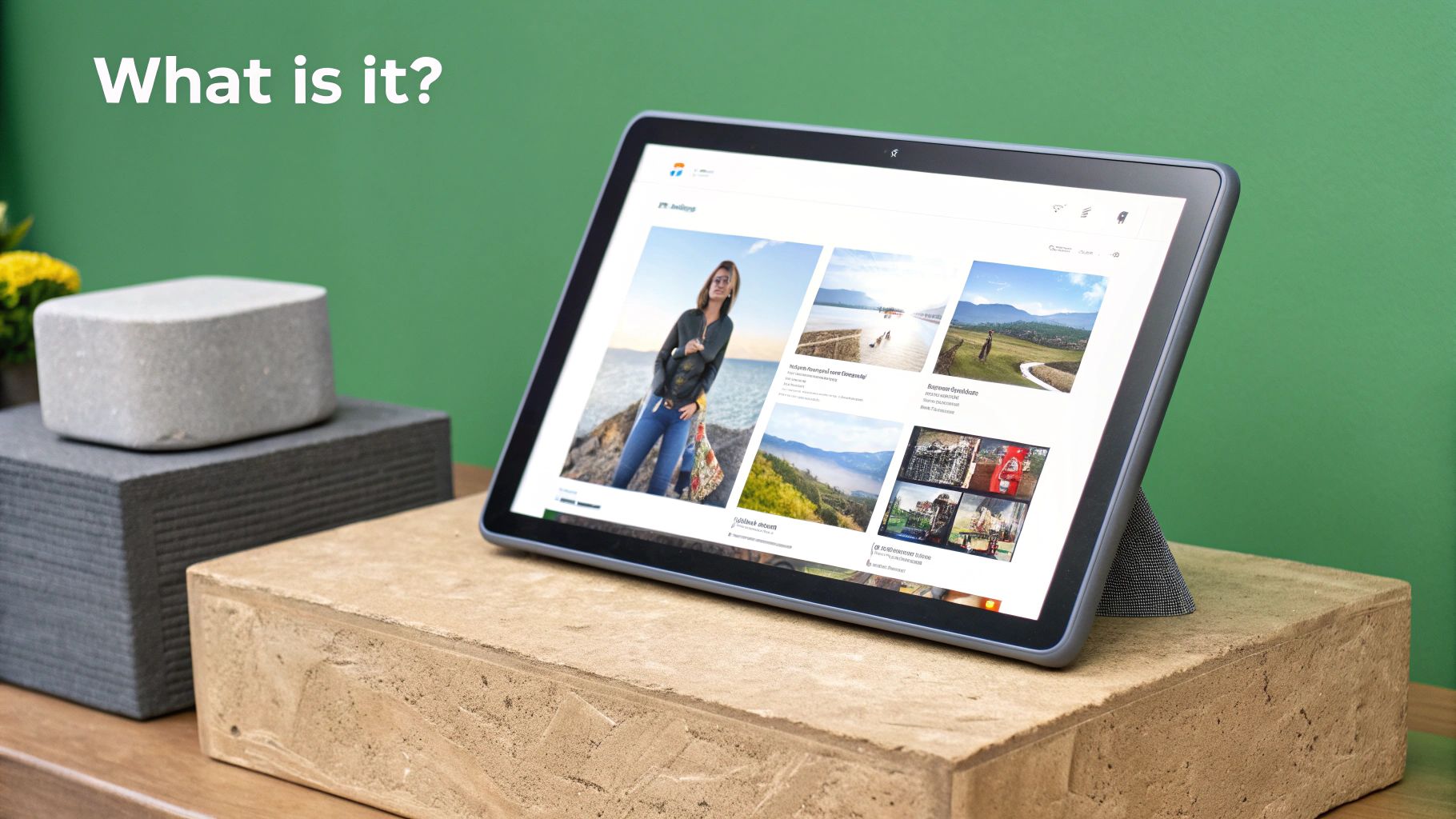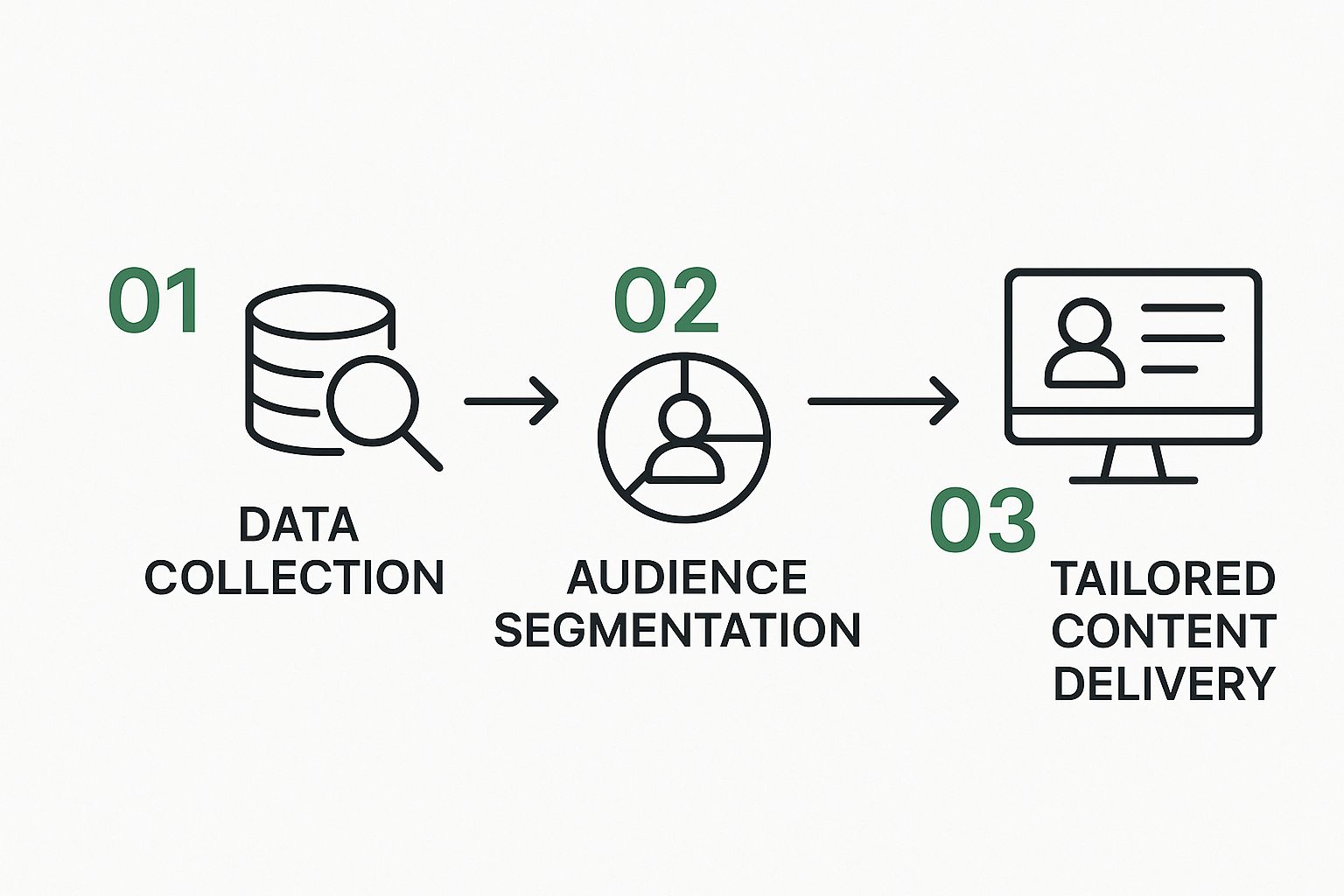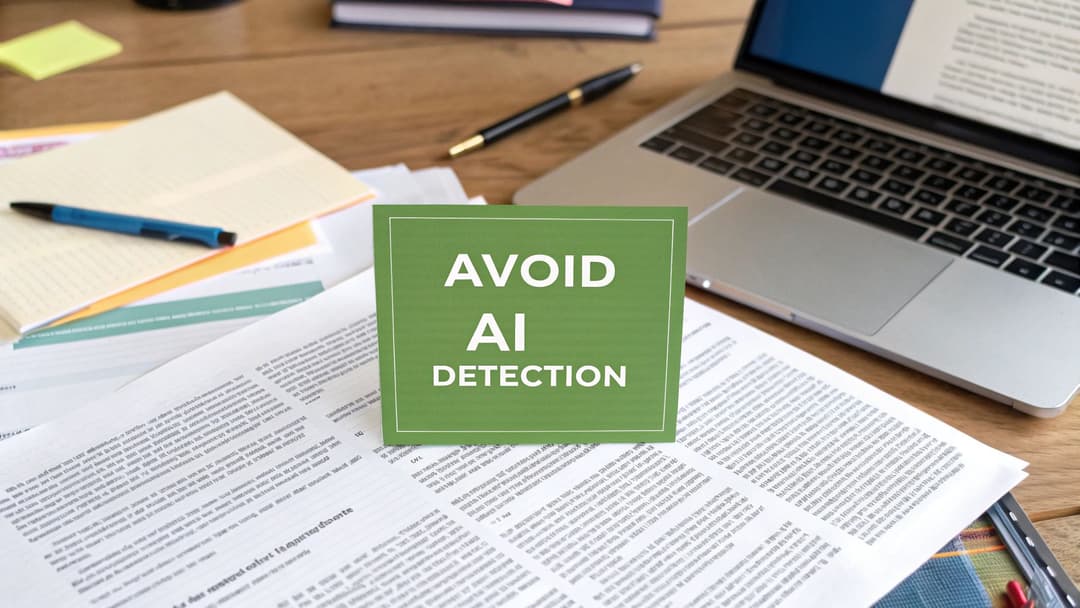
What Is Content Personalization? A Practical Guide
August 24, 2025
Content personalization is all about delivering the right content to the right person at the right time. Instead of shouting one generic message at everyone with a megaphone, it's about having a real, one-on-one conversation with each person who visits your site.
What Content Personalization Actually Means

Let’s cut through the buzzwords. Traditional marketing gives every single visitor the exact same experience, whether they’re a first-time browser or a long-time customer. Content personalization completely flips that on its head by dynamically changing what a user sees based on who they are and what they've done.
The goal is simple: make every interaction feel uniquely relevant and genuinely helpful.
This works by gathering and analyzing user data to get a clear picture of their needs and interests. Once you have that insight, you can serve up the perfect:
- Headlines and offers that speak directly to a visitor’s industry.
- Product recommendations based on things they’ve bought or looked at before.
- Blog posts and articles related to topics they've already shown an interest in.
Consumers now expect this kind of treatment, but there's a pretty big disconnect. While 85% of companies feel like they’re delivering personalized experiences, only 60% of their customers actually agree. That gap is a massive opportunity for brands that are willing to get it right and truly connect with their audience. You can dig into more of these personalization statistics to see what they mean for modern marketers.
Why Personalization Is a Business Game Changer

Knowing what content personalization is is one thing. Knowing why it matters to your bottom line is another.
Simply put, personalization stops your marketing from being just another expense and turns it into a real growth engine. It directly moves the needle on the metrics that actually define success, making every click and every interaction count.
Instead of throwing your marketing budget at a wall and hoping something sticks, you’re delivering real value from the very first interaction. That kind of precision has a massive ripple effect on your finances.
Done right, personalization can slash your customer acquisition costs by up to 50%. It can lift revenues by 5-15% and boost your marketing ROI by a solid 10-30%. The gap is real—faster-growing companies pull in 40% more of their revenue from personalization than their slower-moving competitors. You can dig into more personalization software statistics to see the full picture.
Building Loyalty and Lifetime Value
Acquisition is just the starting line. The real magic of personalization is its power to build relationships that last, turning a one-time visitor into someone who genuinely advocates for your brand.
Think of it this way: a generic, one-size-fits-all experience might get you a single sale. But a personalized journey makes people feel seen and understood. That’s what brings them back again and again.
Personalization is the difference between selling a product and gaining a customer. It shifts the focus from a single transaction to building a long-term, profitable relationship that grows over time.
When you consistently offer relevant content, smart recommendations, and timely help, you dramatically increase customer lifetime value (CLV). A higher CLV means every customer is more valuable over time, creating a sustainable growth model where you aren't just chasing new leads but nurturing the audience you've already earned.
Creating a Competitive Advantage
Let’s be honest, the market is crowded. A generic approach just gets you lost in the noise. Personalization is what makes you stand out. It shows customers you’ve done your homework and actually care about their specific needs, which is the fastest way to build trust.
This tailored approach delivers tangible results you can see in your analytics:
- Higher Conversion Rates: The right offer at the right moment? That’s an easy "yes" for most people.
- Lower Bounce Rates: When content is relevant, people stick around longer. Search engines love that.
- Increased Customer Satisfaction: A smooth, intuitive experience leaves a great impression long after they’ve left your site.
Ultimately, personalization isn't just another marketing tactic to check off a list. It’s a core business strategy that creates a better experience for your customers while driving real, measurable growth for you.
How Personalization Works in the Real World

Content personalization isn't just some abstract marketing concept—you bump into it dozens of times a day. The biggest brands on the planet have built their empires on making you feel like they know exactly what you want, sometimes even before you do.
These experiences feel seamless, but they’re powered by a massive engine of data, algorithms, and a sharp understanding of human behavior.
Think about the last time you opened Netflix. That "For You" row isn't a random guess. It's a finely tuned system that has analyzed your watch history, your favorite genres, the actors you seem to like, and even what time you usually tune in. That’s personalization in its purest form, designed to keep you glued to the screen.
Amazon’s recommendation engine is another legend for a reason. It crunches billions of data points—what you’ve bought, what you’ve browsed, and what people like you have purchased—to suggest products with an almost spooky accuracy. It’s what transforms a simple shopping trip into a curated experience built just for you.
Beyond the Giants: Everyday Examples
You don't have to be a tech titan to pull off effective personalization. It happens in subtle but powerful ways all the time.
Take Spotify's "Discover Weekly" playlist. Every Monday, it drops a custom-made soundtrack for millions of listeners. How? By analyzing your listening habits and matching them with users who have similar tastes, it unearths new music you’re statistically bound to love.
The best personalization doesn’t feel like marketing at all. It feels like a helpful friend who just gets you, making your digital life a little easier and a lot more enjoyable.
Smaller examples are just as impactful and prove how accessible this strategy can be. The tech often involves creating dynamic content on your website, which lets you swap out different elements based on who's looking.
Here’s how you might see it in the wild:
- Dynamic Subject Lines: An email lands in your inbox with a subject like, "John, we found new arrivals you'll love," because the system knows what you’ve been browsing.
- Location-Based Content: A clothing retailer shows you winter coats if you're visiting from a cold climate but displays swimwear if you're somewhere tropical.
- Tailored Calls-to-Action: A software site might show a "Request a Demo" button to someone from a big company but offer a "Start Free Trial" button to a visitor from a small startup.
Each of these examples is driven by data and a simple commitment to being relevant. But as algorithms do more of the heavy lifting, it's more important than ever to keep a human touch. For a deeper look, our guide on how to humanize AI text has some great insights for making automated content feel authentic.
Your Framework for Implementing Personalization
So, you're ready to get started with personalization? Great. But before you dive into the fancy software, you need a clear roadmap. The very first step has nothing to do with technology—it's all about getting your data in one place and actually understanding it.
Without a solid data foundation, even the most ambitious personalization efforts will fall flat. You'll just end up delivering generic experiences that miss the mark completely. A smart first move is leveraging audience insights to get a real handle on how people behave and what they're looking for.
Once your data is in order, you can move on to the most critical phase: audience segmentation. This is where the real magic happens.
Understanding Your Audience Segments
Segmentation is so much more than just basic demographics. To create experiences that genuinely resonate, you need to layer different kinds of data to build a complete picture of your users.
- Demographic: This is the "who" — their age, location, and gender. It’s a decent starting point, but it's rarely enough on its own.
- Behavioral: This is the "what" — which pages they visited, what content they downloaded, or their purchase history. This stuff reveals a user's intent and what they’re truly interested in.
- Psychographic: This is the "why" — their values, interests, and lifestyle. This helps you understand the motivations driving their actions.
When you start combining these, you can create powerful, specific segments like, "first-time visitors from the tech industry who have read blog posts about AI." That level of detail is what makes precise, effective content personalization possible.
It's a pretty straightforward process, but it’s the core logic behind any personalization strategy that actually works.

This flow really just shows how you turn a pile of raw data into tailored experiences that connect with people on a human level.
Choosing Your Tools and Content
With your segments clearly defined, you can start picking the right technology. You don’t have to go all-in at once. You can start small with tools already built into your email marketing platform or CMS. As you scale, you might want to look at dedicated personalization engines that use AI to automate the whole process.
The final piece of the puzzle is creating dynamic content blocks. Think headlines, calls-to-action, or product recommendations that change based on who's looking. By building a library of these adaptable assets, you'll be ready to deliver the right message every time. For a deeper dive into creating great content, check out these content marketing best practices.
Navigating the Common Pitfalls and Challenges
While the promise of content personalization is huge, the road to getting it right is often paved with potholes. It’s not just about buying the right software. Success comes from a smart strategy that anticipates the common mistakes that can trip you up before you even get started.
One of the biggest hurdles is purely technical. Many companies are sitting on a goldmine of customer data that they can't even use because it's stuck in data silos. Think about it: your marketing platform has one piece of the puzzle, sales has another, and customer service has a third. If those systems don't talk to each other, you can never get a complete picture of your customer. And without that unified view, true personalization is basically impossible.
Balancing Helpfulness and Intrusion
Beyond the tech, there's a much more delicate challenge: ethics. There's a fine line between a genuinely helpful recommendation and a creepy, invasive one. And people are paying attention. Privacy concerns are on the rise, with nearly half of all consumers saying they don't trust brands with their data and 41% finding personalized messages outright intrusive. For more on this, check out the latest personalization software statistics and consumer trust on llcbuddy.com.
The goal of personalization is to build trust, not break it. Every piece of data you collect must be used to provide genuine value to the user, with their privacy and consent as your top priorities.
This isn’t just about feeling good—it’s about being transparent. You have to be upfront about what data you’re collecting and why, stick to regulations like GDPR, and always give people control over their own information. Upholding these standards is as non-negotiable as following academic integrity guidelines in a university.
Finally, getting this right requires everyone to be on the same page. It’s a team sport. You have to break down those internal barriers and get different departments aligned on a single vision for the customer experience. By thinking about these challenges ahead of time, you can build a plan that actually delivers value without crossing that creepy line and losing your customers' trust.
Where Personalized Experiences Are Headed Next
Content personalization isn't a "set it and forget it" strategy. It's constantly moving. The experiences that feel revolutionary today will be table stakes tomorrow. Looking ahead, the next wave of personalization is shifting beyond simple segmentation and into a world of predictive, immersive, and truly one-on-one interactions.
The big driver behind this change is hyper-personalization. This isn't just about showing someone content based on what they clicked on last week. It's about using artificial intelligence and machine learning to craft a unique, real-time experience for every single person.
Think of a retail site that doesn't just recommend products you’ve viewed before. Instead, imagine it completely rearranges its layout, messaging, and even its imagery to match your specific style and what you seem to be looking for right now. All in a fraction of a second.
From Reactive to Proactive Engagement
The next major leap is from reacting to a customer's actions to predicting them. Instead of waiting for someone to signal their needs with clicks or searches, predictive analytics will let brands anticipate those needs before they're even fully formed.
The future isn't just about meeting expectations anymore; it's about getting there first. Brands will move from asking "What did you do?" to "What will you need next?"
This means proactively offering the right solution at the right time. For instance, a travel app might suggest booking a rental car for an upcoming flight before you've even thought to search for one, all based on your past travel habits.
Personalization Beyond the Browser
Finally, the canvas for personalization is getting much, much bigger. It’s expanding far beyond websites and email inboxes. The most forward-thinking brands are already figuring out how to create seamless, personal journeys across a whole ecosystem of touchpoints.
- Connected TV (CTV): Serving up ad creative that’s dynamically tweaked based on a household's viewing habits and demographics.
- Voice Assistants: Giving tailored answers and recommendations through devices like Alexa or Google Home.
- In-Store Experiences: Using app data to push personalized discounts or product suggestions to shoppers as they walk through a physical store.
- Smart Devices: Tying into the Internet of Things to create experiences that blur the line between the digital and physical worlds.
This interconnected approach makes sure a customer's experience feels consistent, relevant, and genuinely helpful—no matter how or where they choose to engage. Staying on top of these trends is what will separate the good brands from the great ones.
Got Questions About Content Personalization?
Even with a solid plan, it’s normal to have a few questions about how content personalization works in the real world. Let’s clear up some of the most common ones that pop up when marketers are just getting started.
Personalization vs. Customization
What's the real difference here? People often use these terms interchangeably, but they're not the same.
Personalization is what the system does for the user automatically. Think of Netflix suggesting shows based on what you’ve already watched. It’s using data to predict what you’ll like. Customization, on the other hand, is what the user does for themselves. It’s you choosing the dark mode theme on an app or setting your news preferences. One is predictive and automated; the other is a manual choice.
Do I Need a Huge Budget to Start?
Not at all. This is a common myth. You can get started with simple, low-cost tactics that make a real impact.
Something as simple as using a subscriber's first name in an email subject line or creating an audience segment based on a recent purchase is a great first step. Chances are, the marketing and analytics tools you’re already using have basic personalization features built right in, just waiting for you to use them.
How Do I Know If It’s Actually Working?
You measure it. The best way to see the return on your investment is to run simple A/B tests. Put a personalized version of your content up against the generic one and let the data tell you what’s working better.
Keep an eye on a few key metrics: conversion rates, average order value, engagement rates, and customer lifetime value. When those numbers start to climb on the personalized version, you’ll have hard proof that your efforts are paying off.


